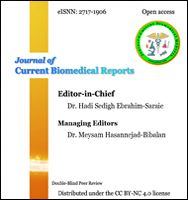Evaluation of clinical and laboratory causes of burns in pre-school children
Abstract
We investigate characteristics of burns in children aged up to seven years and hospitalized at Velayat burn center unit for two years to evaluate clinical and laboratory causes of burns in pre-school children. In a retrospective study, all patients under 6 years who were admitted to Velayat hospital due to burn injuries between 20 march 2016 and 20 march 2017 participated in this study. Baseline data and information collected from hospital HIS system and patient records. The burn-injured children were 283 patients, of which 54.1% were male and 45.9% were female. These injuries mostly were caused by hot liquid (78.7%). The greatest number of burn victims were boys between one and two years old. Almost all the accidents occurred in the home environment (90.1%). A significant correlation was observed between contact burns, serum albumin level, and serum C-reactive protein (CRP) levels with burn severity. Our data demonstrate the importance of developing a program for the prevention of pediatric scalds with the education of family members to be aware of the danger. This knowledge may contribute. the most important and major discovery in our studies so far has been the hypothesis of estimating Albumin 1b peptides (A1b) and CRP laboratory factors during the initial week of hospitalization in the prognosis of children and its constant relation with the severity level of the burns.
Keywords
References
Ahmadabadi A, Tavousi SH, Sedaghat A, Khadem Rezaeyan M, Yaghoubi Moghaddam Z, Lalavi Z. Pattern of burn injuries in preschool children. Saf Promot Inj Prev. 2016; 4(4):225-30.
Seifert J. Incidence and economic burden of injuries in the United States. BMJ Publishing Group Ltd; 2007.
Khadem-Rezaiyan M, Aghajani H, Ahmadabadi A, Zanganeh M, Tavousi SH, Sedaghat A, et al. Epidemiology of severe burns in North-East of Iran: How is the burn size different in a developing country from developed ones? Burns Open. 2020; 4(1):4-9.
Anlatici R, Ozerdem OR, Dalay C, Kesiktaş E, Acartürk S, Seydaoğlu G. A retrospective analysis of 1083 Turkish patients with serious burns. Part 2: burn care, survival and mortality. Burns. 2002; 28(3):239-43.
De Young AC, Kenardy JA, Cobham VE, Kimble R. Prevalence, comorbidity and course of trauma reactions in young burn-injured children. J Child Psychol Psychiatry. 2012; 53(1):56-63.
Balseven-Odabaşi A, Tümer AR, Keten A, Yorganci K. Burn injuries among children aged up to seven years. Turk J Pediatr. 2009; 51(4):328-35.
Shields BJ, Comstock RD, Fernandez SA, Xiang H, Smith GA. Healthcare resource utilization and epidemiology of pediatric burn-associated hospitalizations, United States, 2000. J Burn Care Res. 2007; 28(6):811-26.
Carlsson A, Udén G, Håkansson A, Karlsson ED. Burn injuries in small children, a population-based study in Sweden. J Clin Nurs. 2006; 15(2):129-34.
Libber SM, Stayton DJ. Childhood burns reconsidered: the child, the family, and the burn injury. J Trauma. 1984; 24(3):245-52.
Kent L, King H, Cochrane R. Maternal and child psychological sequelae in paediatric burn injuries. Burns. 2000; 26(4):317-22.
Ghosh A, Bharat R. Domestic burns prevention and first aid awareness in and around Jamshedpur, India: strategies and impact. Burns. 2000; 26(7):605-8.
Wiechman SA, Ptacek JT, Patterson DR, Gibran NS, Engrav LE, Heimbach DM. Rates, trends, and severity of depression after burn injuries. J Burn Care Rehabil. 2001; 22(6):417-24.
Forjuoh SN. Burns in low- and middle-income countries: a review of available literature on descriptive epidemiology, risk factors, treatment, and prevention. Burns. 2006; 32(5):529-37.
Kazemzadeh J, Vaghardoost R, Dahmardehei M, Rabiepoor S, Farzan R, Asghar Kheiri A, et al. Retrospective Epidemiological Study of Burn Injuries in 1717 Pediatric Patients: 10 Years Analysis of Hospital Data in Iran. Iran J Public Health. 2018; 47(4):584-90.
Kao CC, Garner WL. Acute Burns. Plast Reconstr Surg. 2000; 101(7):2482-93.
Verma S, Srinivasan S, Vartak A. An epidemiological study of 500 paediatric burn patients in Mumbai, India. Indian J Plast Surg. 2007; 40(2):153-7.
Rafii MH, Saberi HR, Hosseinpour M, Fakharian E, Mohammadzadeh M. Epidemiology of pediatric burn injuries in isfahan, iran. Arch Trauma Res. 2012; 1(1):27-30.
Joseph KE, Adams CD, Goldfarb IW, Slater H. Parental correlates of unintentional burn injuries in infancy and early childhood. Burns. 2002; 28(5):455-63.
Van der Merwe AE, Steenkamp WC. Prevention of burns in developing countries. Ann Burns Fire Disasters. 2012; 25(4):188-91.
DOI: https://doi.org/10.52547/JCBioR.2.1.27
Refbacks
- There are currently no refbacks.
Copyright (c) 2021 © The Author(s)

This work is licensed under a Creative Commons Attribution-NonCommercial 4.0 International License.













